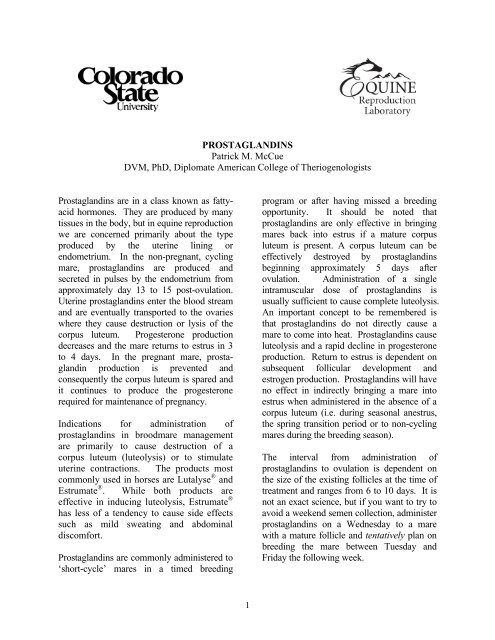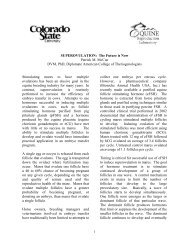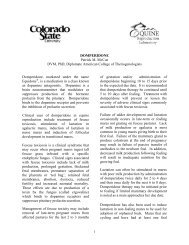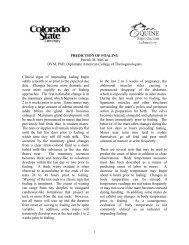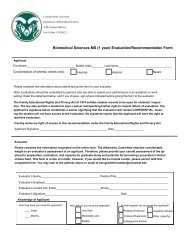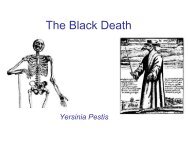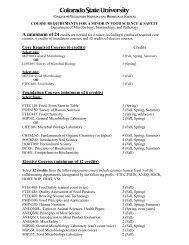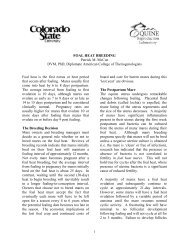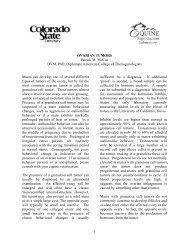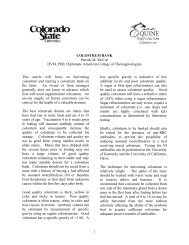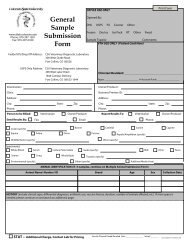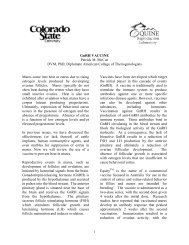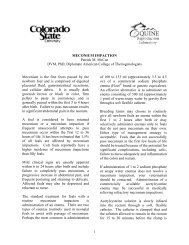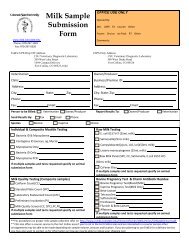PROSTAGLANDINS Patrick M. McCue DVM, PhD, Diplomate ...
PROSTAGLANDINS Patrick M. McCue DVM, PhD, Diplomate ...
PROSTAGLANDINS Patrick M. McCue DVM, PhD, Diplomate ...
You also want an ePaper? Increase the reach of your titles
YUMPU automatically turns print PDFs into web optimized ePapers that Google loves.
<strong>PROSTAGLANDINS</strong><strong>Patrick</strong> M. <strong>McCue</strong><strong>DVM</strong>, <strong>PhD</strong>, <strong>Diplomate</strong> American College of TheriogenologistsProstaglandins are in a class known as fattyacidhormones. They are produced by manytissues in the body, but in equine reproductionwe are concerned primarily about the typeproduced by the uterine lining orendometrium. In the non-pregnant, cyclingmare, prostaglandins are produced andsecreted in pulses by the endometrium fromapproximately day 13 to 15 post-ovulation.Uterine prostaglandins enter the blood streamand are eventually transported to the ovarieswhere they cause destruction or lysis of thecorpus luteum. Progesterone productiondecreases and the mare returns to estrus in 3to 4 days. In the pregnant mare, prostaglandinproduction is prevented andconsequently the corpus luteum is spared andit continues to produce the progesteronerequired for maintenance of pregnancy.Indications for administration ofprostaglandins in broodmare managementare primarily to cause destruction of acorpus luteum (luteolysis) or to stimulateuterine contractions. The products mostcommonly used in horses are Lutalyse ® andEstrumate ® . While both products areeffective in inducing luteolysis, Estrumate ®has less of a tendency to cause side effectssuch as mild sweating and abdominaldiscomfort.Prostaglandins are commonly administered to‘short-cycle’ mares in a timed breedingprogram or after having missed a breedingopportunity. It should be noted thatprostaglandins are only effective in bringingmares back into estrus if a mature corpusluteum is present. A corpus luteum can beeffectively destroyed by prostaglandinsbeginning approximately 5 days afterovulation. Administration of a singleintramuscular dose of prostaglandins isusually sufficient to cause complete luteolysis.An important concept to be remembered isthat prostaglandins do not directly cause amare to come into heat. Prostaglandins causeluteolysis and a rapid decline in progesteroneproduction. Return to estrus is dependent onsubsequent follicular development andestrogen production. Prostaglandins will haveno effect in indirectly bringing a mare intoestrus when administered in the absence of acorpus luteum (i.e. during seasonal anestrus,the spring transition period or to non-cyclingmares during the breeding season).The interval from administration ofprostaglandins to ovulation is dependent onthe size of the existing follicles at the time oftreatment and ranges from 6 to 10 days. It isnot an exact science, but if you want to try toavoid a weekend semen collection, administerprostaglandins on a Wednesday to a marewith a mature follicle and tentatively plan onbreeding the mare between Tuesday andFriday the following week.1
Synchronization of estrus in 2 or more maresfor the purpose of embryo transfer or timedbreeding may be accomplished byadministration of 2 injections of prostaglandins14 days apart. Prostaglandins mayalso be used to terminate an unwantedpregnancy or after a mismating. Inadvertentadministration of prostaglandins to a pregnantmare is highly likely to cause loss of thepregnancy. However, if the mistake isrecognized early, the pregnancy can often besaved by daily administration of progesterone.In the past several years, prostaglandinshave been used as an alternative to oxytocinto expel fluid from the uterus of mares.Prostaglandins have been reported tostimulate uterine contractions for 2 to 4hours or more. In contrast, oxytocin willcause uterine contractions for 30 to 45minutes. It is now relatively common toutilize a combination of uterine lavage andeither oxytocin or prostaglandins to evacuateretained uterine fluid. Uterine fluidretention is especially common in oldermares after breeding and is referred to aspersistent mating-induced endometritis.Affected mares are unable to physicallyclear fluid from their uterus and fluidretention may be associated with a reductionin fertility.Several recent studies have confirmed thatprostaglandins should not be administered tomares after ovulation in an effort to clearuterine fluid. Treatment of mares afterovulation will adversely affect developmentof the corpus luteum, reduce progesteroneproduction and potentially decreasepregnancy rates. Treatment withprostaglandins prior to ovulation does notaffect function of the subsequent corpusluteum. Oxytocin does not have any adverseeffects on corpus luteum development whenadministered either prior to or afterovulation. Consequently, prostaglandins oroxytocin may be used to evacuate uterinefluid prior to ovulation, but oxytocin appearsto be a better choice for treatment of uterinefluid after ovulation is detected.Prostaglandins are one of the most widelyused hormones in equine reproduction.Adherence to the guidelines provided hereand by your equine veterinarian can helpensure the safe effective use of this product.2


